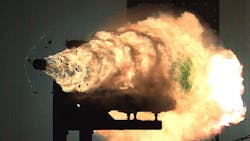U.S. Navy electromagnetic railgun appears dead in the water as researchers eye hypervelocity projectile
DAHLGREN, Va. -- The U.S. Navy’s $500 million electromagnetic railgun -- capable of slinging projectiles at hypersonic speeds -- lacks funding and has no coherent plan to deploy on warships. Popular Mechanics reports. Continue reading original article
The Military & Aerospace Electronics take:
12 May 2020 -- The Navy instead is pursuing an offshoot of the railgun, a hypervelocity projectile it can fire from existing gun systems.
The electromagnetic railgun (EMRG) is a weapon that uses electricity instead of gunpowder to send projectiles downrange. Railguns use magnetic fields created by high electrical currents to accelerate a projectile to Mach 6, or 5,400 miles an hour. The velocity is sufficient to give the EMRG an effective range of 110 nautical miles, or 126 miles on land.
The alternative hypervelocity projectile (HVP) is the same projectile developed for the EMRG but modified to fire from the Navy’s 127-millimeter deck guns. The projectile has a top speed of Mach 3 -- only half the speed as from an EMRG -- but still an improvement over current 127-millimeter projectiles.
Related: BAE Systems to continue development of shipboard power for Navy's electromagnetic railgun
John Keller, chief editor
Military & Aerospace Electronics
